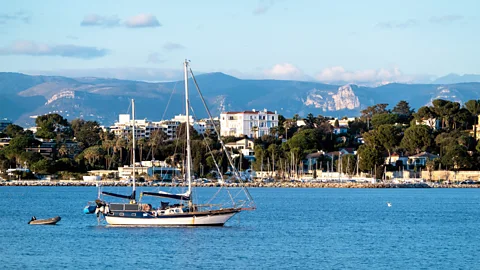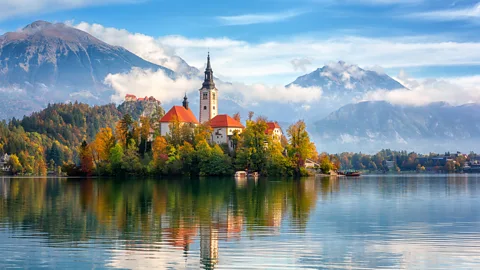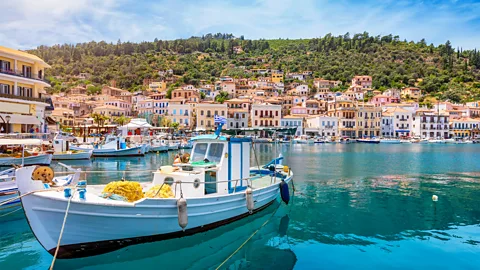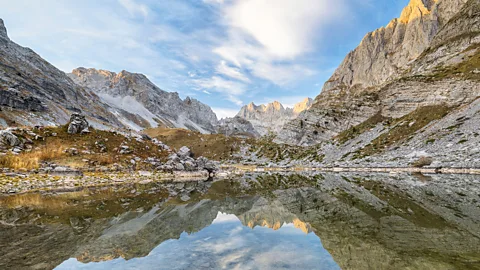Nine European vacation destinations to visit in 2025 if it's not your first time
 Alamy
AlamyFrom romantic retreats in the Mediterranean to fresh-air-filled Alpine hikes, these are the most exciting areas of Europe to visit this year.
While much of Europe is ripe with history, culture, cuisine and breathtaking landscapes, some spots are particularly primed to welcome visitors right now.
This is not your typical all-time European getaway list; you won't find Rome or London here. Paris made the cut because of its post-Olympics peacefulness (plus the reopening of Notre Dame, an icon that has finally found its voice). Instead of a lifetime bucket list, we've curated 2025-specific picks that will make this year's holidays particularly memorable. Many of these are unsung destinations free from the overcrowding that's caused tourism upheaval – and rows with locals – in highly touristed European cities for the last several years.
These are on-the-rise areas of Europe where you can experience iconic cultural sites, spectacular hotels and outdoor adventures. From spending days on the sun-soaked Mediterranean coast to climbing the highest Alpine peaks, here are nine exciting European destinations to visit in 2025.
 Alamy
Alamy1. Puglia, Italy
Puglia saw a 20% jump in international arrivals in 2024 with more than 15 million overnight stays – still a fraction of Rome's 51 million. With two international airports (Bari and Brindisi) and rising interest, now is the time to visit before word gets out much further.
"The heel of Italy's boot offers incredible value compared to the Amalfi Coast with authentic masserie (farmhouse hotels) being converted into luxury properties," says California-based travel advisor and photographer Coco Tran, who has been researching and photographing Italy for years. "The region's celebration of slow food, incredible coastline and Unesco sites like Alberobello make it exceptional," she adds. In 2025, travellers can also experience the Jubilee Puglia, a Catholic event that only takes place every 25 years, aligning with larger events in Rome.
Tran recommends booking a table at cliff-side Osteria Sant'Anna in Polignano a Mare where the morning's catch is served fresh. On warm days, take a dip at Grotta della Poesia (Poetry Cave), a picture-perfect natural swimming hole; or saunter through Lecce's Baroque-filled streets. And while it's a new year, some old favourites remain the same. Tran says Masseria Torre Coccaro remains the spot to stay, with white-washed rooms surrounded by ancient olive groves – plus villas with private plunge pools so you can soak it all in without another guest in sight.
Best time to visit: Puglia's shoulder seasons, in late spring (May-June) and early autumn (September-October), offer ideal weather and fewer crowds.
 Alamy
Alamy2. Alentejo Coast, Portugal
Portugal continues to attract global attention, but there's far more to this Iberian nation than Porto and Lisbon. One region finally stepping into the spotlight is the Alentejo coast, which experienced its best tourism year on record in 2024.
"Portugal's Alentejo coast is finally getting deserved attention, with its pristine beaches and fantastic wineries," says Tran. While many travellers tack the region onto a trip to Lisbon or the Algarve, this breathtaking section of coast is worth a dedicated journey – especially for those seeking nature, history and adventure.
Who picked the list?
Stacey Leasca is an award-winning travel journalist living in Lisbon, Portugal, with two decades of experience covering destinations across Europe and beyond. She served as adjunct professor of journalism at the University of Southern California and is a PhD candidate specialising in building resiliency to disinformation in journalism.
The area's "mix of coastal beauty, incredible cycling routes and overall affordability compared to many other places in Europe" make it an ideal getaway for thrill-seekers, says Maria Elena Price of ExperiencePlus! Bicycle Tours, which hosts tours around the world, including the Alentejo Coast.
Évora, a Unesco-listed city with Roman ruins and medieval architecture, is ideal for history buffs; while Zambujeira do Mar offers one of the nation's most beautiful beaches. Throughout June, travellers can also take part in the famed Festas dos Santos Populares (Popular Saints' Festivals), a nationwide celebration of Portugal's patron saints. Base yourself at Craveiral, a boutique stay where more than 70% of the restaurant's ingredients come from its on-site farm – including the toppings on its wood-fired pizzas.
Best time to visit: Summer is a blast in the Alentejo, with busy beaches and hiking through the Fisherman's Trail. If you prefer thinner crowds, you'll still find spectacular weather in the autumn, between September and November.
 Getty Images
Getty Images3. Andermatt-Sedrun-Disentis, Switzerland
About five million people visit Chamonix a year, while a million others visit Verbier – both rightly famous for their epic snowfalls and fantastic on- and off-piste terrain. However, it's high time global travellers explored the less-touristed European peaks – specifically, Andermatt-Sedrun-Disentis, three interconnected resorts that together offer 180km of skiable terrain. And while the skiing is already supreme, Mike Goar, who is the COO of mountain operations in Switzerland for Vail Resorts, says 2025 will see the investment of 110m Swiss francs (£89.5m) into mountain improvements such as snowmaking, meaning it's only going to get better.
However, this destination is not just for winter. In any season, you can ride the Glacier Express train through the Alpine region, take a day hike to the glacial Lago di Tom or visit the nearby Uri Alps for a multi-day cycling trip. This region offers that small Alpine village feel – including a seemingly endless supply of fondue – and fewer crowds than its better-known Swiss counterparts. Stay at the luxurious Chedi Andermatt, which offers easy access to the slopes; and look out for the Post Hotel & residences by Elie Saab, a fashion-forward hotel expected to open next ski season.
Best time to visit: Andermatt-Sedrun-Disentis is a true all-season destination. You can ski from December through April, hike and bike from June through September and enjoy spring flowers and autumn foliage in between.
 Getty Images
Getty Images4. Cap d'Antibes, French Riviera
Cap d'Antibes is having a cultural moment in 2025, making this glamourous corner of the French Riviera worth another look. This year marks the 100th anniversary of F Scott Fitzgerald's arrival on the Côted'Azur – an event that helped shape the Riviera's Jazz Age legacy – and the literary milestone is drawing renewed attention to the region's artistic significance.
The iconic Belles Rives hotel – Fitzgerald's home for part of the 1920s – is embracing its storied past with a series of celebratory events. "The centennial anniversary of Fitzgerald's arrival makes this legendary hotel more relevant than ever," says Andria Mitsakos, founder of AMPR, which represents the property.
Beyond the hotel, Cap d'Antibes hosts the Juan-les-Pins International Jazz Festival in July, when Bastille Day celebrations bring fireworks and festivities to the beaches. Later in the year, visitors can attend the Festival International d'Art Sacré, one of the region's oldest music festivals. Bonus: you'll be right in the heart of everything the French Riviera has to offer, from golden beaches and dramatic cliffs to cultural sites such as the Picasso Museum and the Chapelle Matisse.
Best time to visit: The summer sun beckons A-listers, making it a great time to come for a bit of celebrity-spotting and warm waters for dipping. For cooler temps and fewer crowds, stick to April-June and September-October.
 Getty Images
Getty Images5. Slovenia
While Italy continues to grapple with overtourism, nearby Slovenia is quietly emerging as a smart alternative, offering spectacular scenery, cultural depth and fewer crowds. With Nova Gorica named a European Capital of Culture for 2025, the timing couldn't be better to explore this captivating nation.
At just under 20,720sq km, Slovenia is a "small but mighty country", says James Montie, branch manager at Fox World Travel, who's seen growing demand from clients looking for off-the-beaten-path destinations. Slovenia's breathtaking landscapes, "from Lake Bled's fairytale setting to the underground wonders of Postojna Cave", are a primary draw, he adds.
More like this:
• The 25 best places to travel in 2025
Independent travel advisor Kimberly Denison agrees that Slovenia is poised for a tourism boom and that now is the time to pre-empt the crowds "Slovenia is a leader in wellness and sustainability, with green-certified cities, boutique eco-lodges and luxurious wellness retreats," she says. It also has bonafide stats to back up its green messaging, including that 60% of the country's surface area is forest and it was certified as the world's first green destination in 2016.
To explore its glorious landscapes, hike Triglav National Park, home to Slovenia's highest peak, before overnighting at Vila Bled, a historic lakeside retreat that looks like it should be a summer house for royals.
Best time to visit: The warmer months between May through September offer the greatest opportunities to enjoy outdoor adventures.
 Getty Images
Getty Images6. Peloponnese, Greece
The Greek Islands are a perennial favourite, but in 2025, it's the mainland that's set to shine – specifically the outstretched fingers of the Peloponnese. Greece is investing heavily in the region this year, upgrading infrastructure like the Mycenae road network and directing funding towards sustainable agritourism and local olive producers. The result for travellers is easier access, deeper cultural connection and fewer crowds.
Of the Peloponnese's three peninsulas, Mani – the rugged middle finger – stands out. "Far from the Cycladic island buzz, Mani is Greece's best-kept secret," says Mitsakos, who lives in Greece and represents a boutique hotel in Mani. "This rugged, sun-scorched region is a treasure find for travellers seeking authenticity, serenity and deep cultural resonance." Expect cobblestoned villages, pristine beaches and hidden coves, along with "a deep-rooted history", she adds. Stay at Pirgos Mavromichali, a restored 18th-Century tower turned boutique hotel where whitewashed rooms overlook the bay's turquoise waters.
Elsewhere in the region, travellers can visit Olympia, the birthplace of the Olympics; or relax on Voidokilia Beach on the west coast. Mitsakos also recommends traditional villages like Milea, Rigklia and Exoxhori for their vibrant folk feasts that are reviving local traditions.
Best time to visit: Greece is packed in the summer, but thanks to the mainland's slightly warmer temperatures, you can get away with a warm-weather break with fewer crowds from April to June and September to October.
 Getty Images
Getty Images7. Paris, France
Paris had quite the 2024 hosting the Summer Olympics, which means the crowds have thinned and prices dipped back down for 2025. Plus, travel here is now easier than ever; since 1 January 2025, the Paris metro system no longer relies on a complicated zone system with extra fares for the banlieues (suburbs). Today, you can use a single ticket to travel the entire network for up to two hours.
What parts of this renowned city should you prioritise? Paul Holinaty, who specialises in Central and Northern European travel at Goway, says you should hit up the neighbourhoods on the Left Bank of the Seine in particular. "Saint Germain des Pres and Luxembourg gardens are close enough to the main sites," he explains, "but nicely tucked away, where you can still find really authentic bakeries, local shops and amazing cafe culture – there's a lot of locals buzzing around the area too." The Rive Gauche is also home to plenty of book shops, theatres and elegant boutiques, making the whole area something out of a romantic film. Travellers can also rediscover an old favourite, thanks to Notre Dame reopening its doors at the end of 2024. As for where to stay, the classic Hôtel du Savoir, formerly called the Hôtel Petit Belloy, just reopened post-reno (done by Laune Architecture) in Saint-Germain-des-Prés and is, let's just say, trés chic.
Best time to visit: Paris is a feast for the senses in all seasons. That said, it's particularly lovely in spring, from April to June, with flowers blooming and longer, sunnier days.
 Alamy
Alamy8. Sweden's west coast
Tourism to Sweden has surged in recent years, driven in part by the rise of the "coolcation" trend where travellers seek out more temperate destinations for their summer getaways. With pristine landscapes, clean air and progressive values, the Nordic nation fits the brief perfectly. Even in the height of summer, temperatures rarely break 20C, making it a compelling alternative to the heat of southern Europe.
While many first-timers gravitate to Stockholm, the west coast remains a wilder, more rugged alternative; think granite islands, salty air and seafood straight off the boat. The long summer days and crisp nights create ideal conditions for kayaking, hiking or just soaking up the Nordic light – minus the crowds and queues of the capital.
It's also a fantastic place for sustainability-minded travellers, with Gothenburg, Sweden's second-largest city, recently awarded the EU's Mission Label for its ambitious plans to become climate-neutral by 2030. Check in at Hotel Pigalle, a boutique hotel with vintage flair and eco-conscious touches, including bio-cleaning products and locally sourced ingredients. If you're seeking more solitude than the city can offer, the Bohuslän archipelago beckons with low-impact adventures, island-hopping and some of the best shellfish you'll ever taste.
Best time to visit: June-August brings long daylight hours, with sunsets at 22:00 and the best weather for coastal adventures.
 Alamy
Alamy9. Albania
Albania has long been one of Europe's most underrated destinations, but that's changing fast. Thanks to relaxed visa requirements and expanded international flight routes, the country is quickly rising on the travel radar. In 2024, Albania welcomed a record 11.7 million international visitors, a surge driven in part by the global rise in interest in lesser-known Mediterranean escapes – which means that now is prime time to see this beautiful country before it books up.
"Albania is quickly gaining recognition for its mix of history, unspoiled coastline and emerging food and wine scene," says Denison. "The Unesco-listed town of Gjirokastër, the pristine beaches of the Albanian Riviera and the vineyards of Berat create a Mediterranean escape that is still under the radar but rapidly gaining momentum."
New infrastructure projects are smoothing the journey (fewer potholes are always a plus). Albania is also investing in luxury accommodations, including the Green Coast Hotel near the Unesco World Heritage site of Butrint, which is set to provide unparalleled luxury nestled among the sea caves. "Albania is poised to become a major player in luxury travel," Denison adds.
While hotpots like Ksamil are growing in popularity, travellers who venture just a little beyond the crowds are rewarded with clear turquoise waters that rival the Greek Islands. Inland, the Accursed Mountains' dramatic landscapes draw hikers and adventure seekers to the country's rugged north. Stylish coastal stays like La Brisa Boutique Hotel in Dhermi place you just steps from the sand; while major developments like the new Marriott in the Vlora Marina (expected to open in 2028) signal that this Mediterranean up-and-comer won't stay quiet for long.
Best time to visit: The summer months are prime time in Albania – and not yet experiencing the crowds of neighbours like Greece. The warm weather makes for ideal beach, hiking and exploring conditions.
Want to explore even further? Check out the BBC's 25 Best Places to Travel in 2025.
--
If you liked this story, sign up for The Essential List newsletter – a handpicked selection of features, videos and can't-miss news, delivered to your inbox twice a week.
